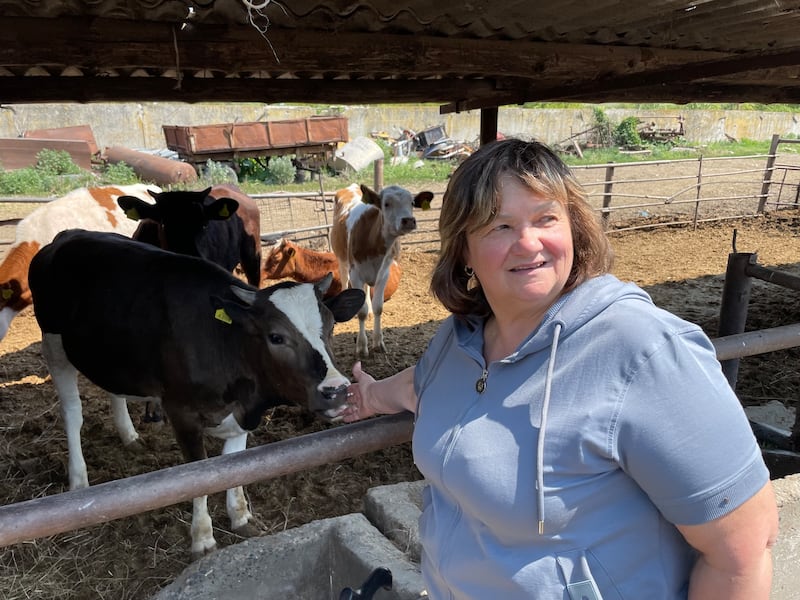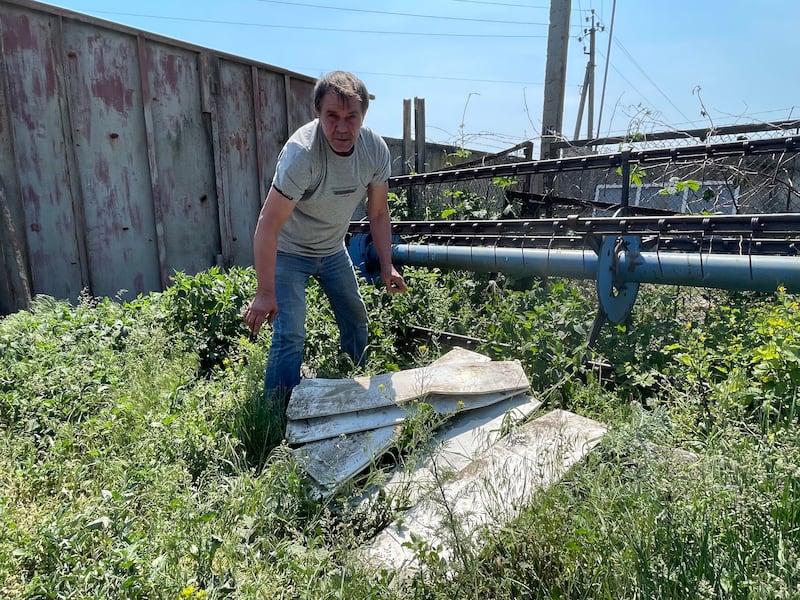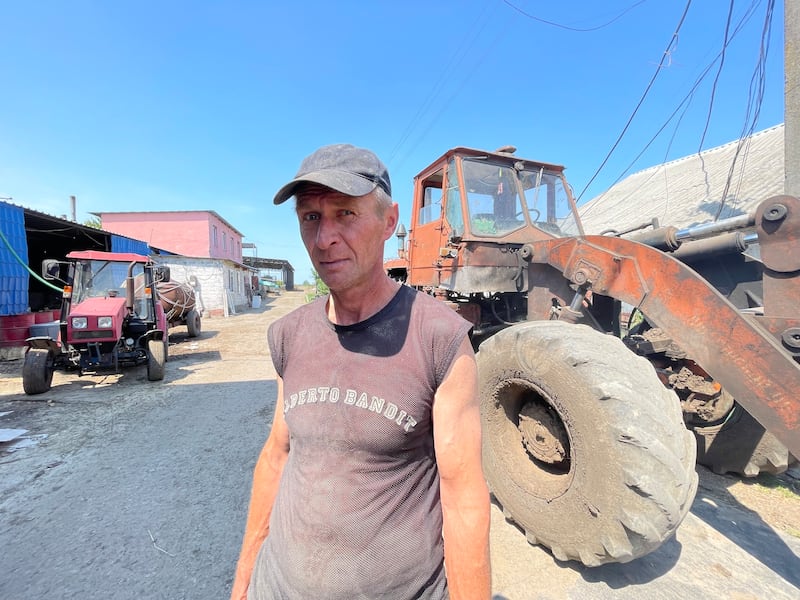Corn is ripening under a hot sun in the green fields of Mala Rohan village in eastern Ukraine, and on Lubov Zlobina’s farm, an old tractor putters through the dusty yard as her cows quietly approach and nuzzle her hand through the fence of their pen.
The peace feels precious because Mala Rohan survived a month of Russian occupation, several buildings on Zlobina’s farm still lie in ruins, and nights are often shaken by the roar of air defence systems that shield the nearby city of Kharkiv, downing drones which crash in the fields and end up joining a pile of debris by the farm gate.
Since Russia’s all-out invasion in February 2022, Ukraine has become the most mined country in the world. Several million hectares of land are littered with unexploded ordnance, and more than 1,000 civilians have been killed or injured by these hidden dangers, including many farmworkers.
Ukraine’s farmers have lost acreage, income and export routes to the war, many of their staff have been drafted into the army, and getting compensation for damaged property and equipment can obviously be a long and frustrating process in such circumstances.
The threat of fresh fighting on their land is an additional risk in front-line regions such as Kharkiv, where Russia launched new ground attacks and intensified air strikes this month, but Zlobina says all she can do is plough on and hope for the best.

“The farming life is never easy, but compared to how things are now, it used to be very good before – I could plan things out, organise everything,” she says of her agricultural property, which was founded as a Soviet collective farm in 1938 and which she has now run for 20 years.
Hundreds of Zlobina’s cows, sheep and pigs died during the occupation of the village by Russian troops at the start of the invasion – when the farm was shelled several times, and her family and staff hid in a basement as shrapnel ripped through walls and doors and shattered windows.
The worst attack came as Ukraine’s forces closed in on the village in late March 2022, and the Russians launched a last salvo at the farm in what Zlobina thinks was revenge for her refusal to collaborate with them.
“They fired from a ‘Solntsepyok’ and hit a big cattle shed,” she says, referring to a feared Russian heavy flame-thrower system that can launch multiple rockets with incendiary and thermobaric warheads.
“The whole place went up in flames and we could do nothing to save the animals. About 140 cattle were killed, all the automated equipment inside was destroyed.” she adds. “The warm shed where calves and pigs spent the winter was also destroyed. It was just hell.
When we went back through the checkpoint, our lads would try to stop us. ‘You can’t go that way, it’s all burning over there,’ they’d say. ‘We know, that’s exactly where we’re going,’ we replied
— Lubov Zlobina, farmer
“I can’t even imagine how much it would cost to replace everything,” Zlobina says, standing between the gutted shells of her livestock sheds. Her husband, Mykola, estimates the damage at hundreds of thousands of euro.
Mala Rohan is barely 40km from the border, and Russian troops seized it just four days into their invasion as they tried to occupy Kharkiv, Ukraine’s second city.
“They went around stealing everything,” Zlobina (64) says.
“The took everything from the cellars – food, tools, equipment – and even stole our shoes. But we stopped them taking our vehicles and our fuel,” she adds.
“Some traitor in the village told the Russians that we’d just bought four tonnes of diesel. But we put it in canisters and buried them in the manure, so they didn’t get it. And we let down the tyres on some vehicles and removed various electronic gadgets from a big truck they would have stolen, and just told them that it didn’t work.”

With the main road to Kharkiv blocked, Zlobina and her husband made risky journeys along back roads to the city to bring bread and other supplies to the village.
“At one of our [Ukrainian] checkpoints on the edge of Kharkiv, Mykola would tell the lads where the Russians’ positions were. He told them where they should strike, and they replied: ‘With what?’” she says, recalling Ukraine’s weapons shortages at the time.
“When we went back through the checkpoint, our lads would try to stop us. ‘You can’t go that way, it’s all burning over there,’ they’d say. ‘We know, that’s exactly where we’re going,’ we replied.”
As an important employer in the village and local council member, Zlobina was exactly the kind of person the Russians sought to recruit in places they seized. Refusal to collaborate, and any suspicion of forwarding information to Ukrainian forces, could lead to arrest, beatings, torture and – in several occupied areas – summary execution.
“They came here for the last time on March 24th [2022] and pressured me from about 2pm until 6pm. They didn’t hit me, but kept saying that I should work with them, that I should call the head of the village council to come over here right now,” she says.
“‘You flew a flag over the farm,’ the one in charge said. ‘Yes, because I’m in Ukraine and it’s the Ukrainian flag,’ I replied. One of them stood there silently with an automatic rifle. He was so quiet that I thought he might kill me at the end,” Zlobina recalls.
“‘When we come back tomorrow, the conversation will be different. And if not…,’ the main one said, and then jabbed me in the chest. I could feel that jab for months afterwards. But they never came back.”
Fighting intensified over the following days and then the Russians fled, but not before shelling Zlobina’s farm as she hid with her relatives and staff in the basement, listening helplessly as flames engulfed a barn full of animals just across the yard.
“It was March 26th, my birthday, and they did that as they were leaving. It was revenge, I think,” she says.
Her husband found an abandoned Russian tank in the fields that was put into service with Ukraine’s forces, and the farm got back to work as soon as possible.

Vitaliy Denisenko recalls a dangerous episode when driving a tractor soon after the Russians withdrew. “On May 12th that year I was digging up crops in the fields when there was an explosion. I didn’t even hear it, I was knocked out straight away.
“I came round in the cabin and the tractor was wrecked, the wheels had been blown off. Luckily I just had a cut ear, because the tractor had been turning, so I was leaning out of the window. If not, the windscreen could have shattered in my eyes.”
Denisenko, who has worked at the farm for four years, says it was an anti-tank mine that blew up under him. “But since then everything’s been fine,” he adds.
Studies of satellite data show that about 7 per cent of Ukraine’s arable land has fallen into disuse since 2022, most of it along a front line in the east that now stretches for some 1,200km. The country harvested about 81 million tonnes of grains and oilseeds last year, down from some 110 million tonnes before the full-scale war.
The Mala Rohan farm, which covers about 60 hectares, has retained all its staff through the full-scale war and plans to gradually restock its animals and expand operations, despite daily bomb, missile and drone attacks on Kharkiv and renewed fighting in border areas of the region.
“We’re developing now,” Mykola says. “What will be will be. We got through occupation, so we hope the worst has passed.”
[ 'An artillery barrage came in ... that's when I lost my arm'. Opens in new window ]
[ The young Dubliner flying drones for UkraineOpens in new window ]
- Sign up for push alerts and have the best news, analysis and comment delivered directly to your phone
- Find The Irish Times on WhatsApp and stay up to date
- Our In The News podcast is now published daily – Find the latest episode here












